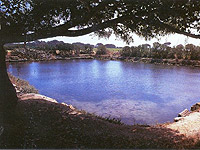
The Reserve of the Stagnone - Mothia
Suggestive and sensual, the Oriented Natural Reserve of the Stagnone extends, inside the territory of Marsala, for a long distance, from Cape Lylibeo to San Teodoro (St Theodore). This is a very particular place: from a zoological point of view, it represents a natural laboratory where new organisms form and evolve before comparing with open sea. Only European habitat to have such a privilege, it deserves a special respect for this reason. The name of the Reserve refers to the fact that the wide involved stretch of sea is separated from the rest of the Mediterranean Sea by a big natural breakwater, the Isola Grande (the Great Island), which makes its waters placid and calm. Inside the lagoon, there is a small archipelago of islets: the Great Island, Mothia, St Mary, and the small rock of Schola, so called because of the people belief that in Roman Age there was here a school of rhetoric. Here the sea keeps very low so that it is possible to go through it for a long distance without the sea-level exceeds the height of knees. In its maximum depth the water reaches 3 metres but from Saint Theodore it is also possible to reach the Long Island walking and until some decade ago carts and horses had been plunging into the water to reach Mothia. In summertime it is possible to see somebody windsurfing or canoeing, just because the low and calm waters guarantees the total safety for the beginners too. There is also the one who has a bath in there: this stretch of water, with an elevated salinity, in summertime gets pleasantly warm, with unusual temperatures for the other areas of the territory. You will need only to look at the Stagnone from the shore and just after you will fall in love with it: the way pass just near the water and a ride on bicycle, or if you prefer a drive, it will allow you to look at the islands, all clearly visible one near the other, the low and calm water, the tufts of spontaneous vegetation that grew up here and there and at last the salinas with their windmills. The Stagnone Reserve is in fact a wonderful combination of nature, history and human deed melting together to create a unequalled and breathtaking landscape. The island of Mothia keeps numerous archaeological findings of that age when its position in the Mediterranean made it an important Phoenician trade port so that it damaged Dionysius of Syracuse who destroyed it in 397 B.C. The salinas are one of the oldest and of the most productive activities of this area to which nature has given a very pleasant climate to gather the salt from its waters, to make it dry with solar heat and at last to dry it in the wind, so that to the passers-by it is given the opportunity to enjoy the spectacle of those enormous white mountains behind which the sun goes to sleep while, a little further on, the shapes of the little islands peeps out. Management Institute: Regional Province of Trapani – via Vito Carrera, 23 –
phone (+39) 0923 873678 How to reach it – To reach Mothia, many times a day there is a special service that sails from the apposite pier in C/da Spagnola ( Spagnola district). FLORA & FAUNA The Flora
The spontaneous vegetation, that enrich and decorate the reserve, is rather various and its survival is due to the tides motion thanks to which the effects of the short depth and of the high summer temperatures, that, in itself, would make impossible every kind of animal and vegetal life, fade. Its conservation is considerably important because is part of a larger plan of protection of the whole triangle among Trapani, the Egadi Islands and Cape Feto, that is the part of sea where the Poseidonia Oceanica, a submarine little palm living only in extremely cleaned waters, is present. In some expanses, it forms some little atolls that give hospitality to several others animal and vegetal populations. You may find others species of Poseidonia only in Australia. Besides the Stagnone an exceptional characteristic: in its waters species, that out of here would be incompatible, that would fight one against the other for survival or being simply part of different ecosystems, strangely succeed in cohabiting. The zones with greater salinity give hospitality to the Suaeda maritime, the Glasswort, the Salsola soda, the Liomonio of the Salinas: all halophilous species able to withstand elevate salt concentration. You may find the Calendula maritime, herbaceous little plant with yellow flower-heads only present in western Sicily, on accumulation of Poseidonia deposited by the sea along the coast-line. The Cane and the Inula grow where the brackish water makes its effects less felt. The Mediterranean scrub, with thermopile species such as the Lentisk, the Little Palm, the red Cistus, the prickly Asparagus, grows in the inner areas of the islands. Some decades ago, groves of Pine of Aleppo was been planted on the Great Island and on the one of St Mary. In Mothia, the Vine is still cultivated, and on the tiny Schola you often see the Ferula, an high herbaceous plant with plumose leaves and big yellow flowers. The Fauna
The birds – When the migrators comes back from Africa to Europe, they avail themselves of the damp, and so rich in food, habitat of the Stagnone to restore a little. The Reserve of the Stagnone and the one of the Salinas of Trapani and Paceco have by this time remained among the few oasis of comfort that you meet on the way of the big and small Killdeers, of the Kentish Flover that hides its eggs among the leaves of Poseidonia, of the Stilt-bird and of the Avocets that here reproduce. Already in July, the Stagnone gives hospitality to the autumnal migrators: the hook-bill Curlew and the Glossy Ibises with their dark plumage. Then, flights of Stock Ducks, with the Duck-hawk lying in wait, Pochards, Teals, Bald-coots, Wild Ducks, Pintails and Garganys arrives when it gets cold. Wonderful is the image of the superb and proud Herons, intent on looking for food among the tanks of the salinas. It will not be difficult for you to notice there the Ash-grey Herons, the snow-white Egrets, the Cormorants, the graceful Spoonbills, that will go away from the Stagnone only in spring and even the Kingfishers, that, when open their wings, show all the beauty of their sky-blue plumage. The Kestrels, well-known for their diving flights on the preys, and the Osprey, very skilful in diving into the water. After all, the coastal brackish habitats allows the survival of a little butterfly, the Licena fenicia. The fishes – The marine fauna of the Stagnone is different depending on the zone examined. Particularly we distinguish two areas: the first, southern, has greater opportunities of communications to the open sea, whereas the second, northern, gives hospitality to forms of life more properly concerned to lagoon habitats. This is the reason because in the first one we find sargos, gilthead breams and mullets, and in the second one only smaller fishes with a short cycle of life.
|

